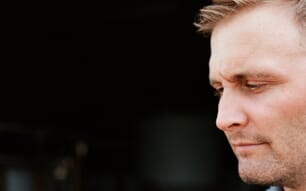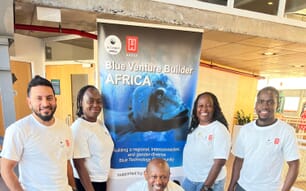Identity
Dicentrarchus labrax Linnaeus, 1758 [Moronidae]
FAO Names: En - European seabass, Fr - Bar européen, Es - Lubina

Biological features
Body rather elongate. Opercle with 2 flat spines; preopercle with large, forward-directed spines on its lower margin. Mouth terminal, moderately protractile
Vomerine teeth in a crescentic band, without a backward extension on midline of roof of mouth. Two separate dorsal fins; the first with 8 to 10 spines; the second with 1 spine and 12 or 13 soft rays. Anal fin with 3 spines and 10 to 12 soft rays. Scales small; lateral line complete with 62 to 74 (mode 70), but not extending onto caudal fin.
Caudal fin moderately forked.
Colour silvery grey to bluish on the back, silvery on the sides, belly sometimes tinged with yellow. Young with some dark spots on upper part of body but adults never spotted. A diffuse spot on the edge of opercle.
View SIDP Species fact sheet
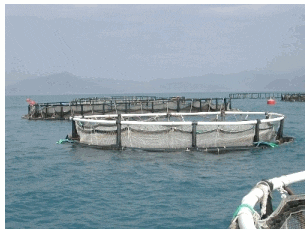
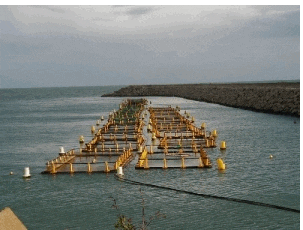
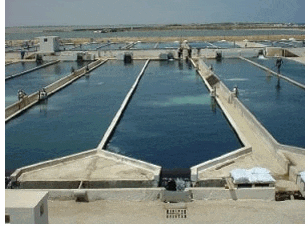
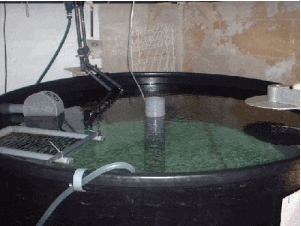
Profile
Historical background
Seabass were historically cultured in coastal lagoons and tidal reservoirs before the race to develop the mass-production of juveniles started in the late 1960s. Fish culture was initially associated with salt production in coastal evaporation pans and marshes. The salt was harvested during the high evaporation season of summer and autumn, and fish were cultured during winter and spring. The supply for this culture came from trapping schools of fish that lived in these estuarine areas.
During the late 1960s, France and Italy competed to develop reliable mass-production techniques for juvenile seabass and, by the late 1970s, these techniques were well enough developed in most Mediterranean countries to provide hundreds of thousands of larvae. The European seabass (Dicentrarchus labrax) was the first marine non-salmonid species to be commercially cultured in Europe and at present is the most important commercial fish widely cultured in Mediterranean areas. Greece, Turkey, Italy, Spain, Croatia and Egypt are the biggest producers.
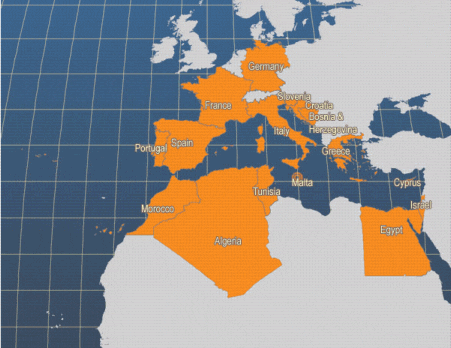
Habitat and biology
The European seabass are eurythermic (5-28 °C) and euryhaline (3‰ to full strength sea water); thus they are able to frequent coastal inshore waters, and occur in estuaries and brackishwater lagoons. Sometimes they venture upstream into freshwater. There is only one breeding season per year, which takes place in winter in the Mediterranean population (December to March), and up to June in Atlantic populations. Seabass spawn small (1.02-1.39 mm) pelagic eggs in water with salinities lower than 35‰, near to river mouths and estuaries or in littoral areas where the salinity is high (=30‰). Being not particularly sensitive to low temperature some fish may over-winter in coastal lagoons instead of returning to the open sea. Seabass are predators and their feeding range includes small fish, prawns, crabs and cuttlefish.
Production
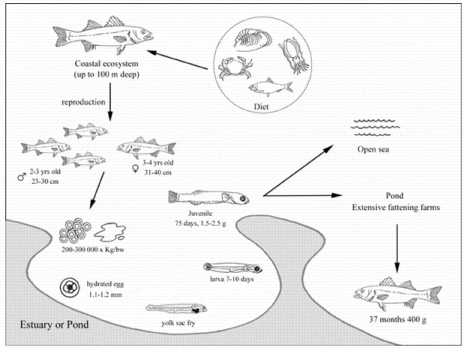
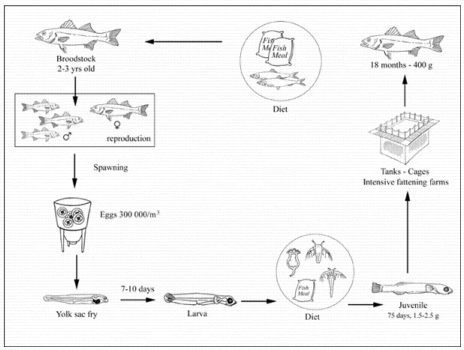
Production systems
Although seabass are farmed in seawater ponds and lagoons, the bulk of production comes from sea cage farming.
Extensive lagoon systems
The traditional extensive method of lagoon management places special barriers in appropriate lagoon sites to capture fish during their autumn migration to the open sea. Barriers made of reeds, nets or cement stay open from February until May for the lagoon to be naturally stocked with fry. In this system seabass is usually cultured in polyculture with seabream, mullets and eels. Seabass reach a commercial size of 400-500 g in 37 months, with a total lagoon production of 50-150 kg/ha/yr. The limiting factor is in the natural feeding behaviour of the seabass that, as predators, may drastically reduce the natural resources of the lagoon ecosystem.
Semi-intensive lagoon systems
These techniques involve artificial enrichment with fry, fertilisation of the lagoons, and improvement projects. Specialist fishermen collect fry from coastal waters during May and June; then fry are transported in oxygenated tanks for a first stage of growing in special ponds, until they reach a size which enables them to survive in the lagoon. Projects for improved productivity involve the development of sufficient canals and making new openings to the open sea for water exchange and enrichment with plankton and fry. Peripheral ditches (with fresh or seawater) are dug for salinity control, and also wintering ditches at least 2 m deep in several areas of the lagoon. Finally, vegetation control is important in order to avoid suffocation of the fish. Losses in fish production in the lagoons are due to insufficient enrichment with fry, predation, decreased freshwater supply (due to lack of rain), and lack of sufficient improvement projects. The production is higher than in the extensive system and amounts to 500-700 kg/ha/yr.
Hatchery production
Broodstock
To secure a reliable and sufficient supply of good quality fish eggs, most hatcheries have established their own broodstock units, where breeders of different age groups are maintained long-term. Parent may come either from a farm or from the wild. The optimal age for female parent fish is between 5 and 8 years, whereas for males this range is lowered to 2-4 years. The management of captive broodstock in the breeding stations includes natural maturation, the induction of ovulation by photoperiod manipulation or hormonal treatments, fertilisation in spawning tanks and incubation in an open-water circulation system.
Spawning
At the onset of the spawning season it is necessary to move selected batches of breeders from their long term holding facilities to the spawning tanks, where they can be better treated and their performance can be easily monitored. The male:female ratio in the spawning tanks is kept at 2:1. Whereas males are chosen when they release sperm spontaneously or on stripping, the female maturation stage has to be ascertained by extracting oocytes from the ovary with the use of a catheter: only females with oocytes in the late-vitellogenic stage, i.e. with a diameter larger than 650 µm are selected.
Photoperiod manipulation
When fertilised eggs are required outside the natural spawning period, out-of-season sexual maturation is obtained by promoting gametogenesis by manipulating the photoperiod and temperature. The hatchery management decides on the periods of egg production according to its marketing and/or farm needs.
Hormonal treatment
Hormonal treatment is used to trigger the last phase of egg maturation. The human chorionic gonadotropin (HCG) is used at a dosage of 800-1000 IU per kg/bw, delivered in two injections in the dorsal muscles, 6 hours apart.
Ongrowing techniques
In intensive production, ongrowing units are supplied with fry from hatcheries and controlled diet is provided.
Juveniles are sold to farmers as ongrowing stock at a size of 1.5-2.5 g. The ongrowing juveniles reach 400-450 g in 18-24 months. Feeds are distributed by automatic feeders every 10-15 minutes for small fish (2-15 g), or by hand for larger fish. Grading is necessary at least two or three times per cycle, in order to avoid growth differentiation and cannibalism. Fattening can occur in tanks or in cages system.
Cage systems
Net-pens (cages) can be of different kinds but the principle is the same; all types are based on a natural exchange of water through pens. The quality of sites is therefore highly variable, according to local conditions such as tide and current. The cages are usually made of steel with areas of 4 to over 10 m², having nets suspended below the walkways up to 6-8 m deep. Some farms are anchored close to the land and can be served from a landing. Others are located in the open sea or in the middle of a protected bay and can only be served by boat. An important factor is the husbandry of the pens; frequent net changing is essential, especially in hot periods (every 15-20 days); weekly cleaning to remove fouling organisms and periodical treatment with anti-fouling products is also necessary. The removal of dead and moribund fish by divers is done, usually weekly but preferably daily during outbreaks of problems.
Tank systems
Tanks are usually supplied with seawater (38‰) maintained in a continuous flow-through system under ambient temperature. Alternatively, brackishwater (30‰) pumped from adjacent lagoons may be used. High stocking densities are applied (20-35 kg/m³); this means that accurate control of water quality and careful observations of fish health are essential. A recirculation system, to control water temperature (between 13-18 °C) is used during autumn/winter, frequently full-time in hatchery and the pre-fattening phase of the production cycle; this system is also used for fattening in high technology farms. This practice improves growth but can be highly expensive due to the required technology for water quality control (filtering, air stripping, UV treatment, catabolite removal).
Harvesting techniques
Commonly fish are fasted for several days before slaughter, ranging between 1 to 12 days depending on seasonal variation of the water temperature. In commercial farms, either land-based tanks or cages seabass are harvested with dipnets or vacuum pumps in very high densities (70-100 kg/m³), just before killing by asphyxiation in chilled water. In the case of sea cages, harvesting is practicable only when weather conditions are acceptable for worker safety.
The time between the harvesting and slaughtering depends on the distance of the cages to the farm, usually not more than two hours, including transport. When the farm has its own slaughtering facility, fish are placed in chilled water with slurry ice and immediately slaughtered.
Prolonged crowding before harvesting is avoided, to ensure high product quality and fish welfare. Greater muscle activity at slaughter leads to a rapid decrease in energy reserves (i.e. adenosine triphosphate, ATP), and to the build up of lactic acid and consequently a drop in post-mortem pH. An animal that struggles at slaughter goes into rigor very rapidly, adversely affecting the quality of fish fillets by softening the muscle texture.
Killing methods should result in rapid and irreversible loss of consciousness. Methods that kill fish rapidly result in a reduction of stress, thus an improvement in welfare and in quality. It has been demonstrated that methods that leave the fish insensible are spiking of the brain, a blow to the head or the destruction of the spinal chord. However, these killing procedures are less practicable in commercial situations for seabass, due to the commercial size of fish and the high cost of qualified personnel.
Handling and processing
Harvesting methods vary according to the scale of the operation. The need to harvest large volumes quickly requires automation, although smaller operations can rely on manual methods. In either case the aim must be to maintain the quality of final product through careful handling, practiced by qualified personnel. Handling includes transfers from one rearing unit to another, as well as during the harvesting and transport of live fish. Hygiene should follow the general principles used in processing. Nets and tanks must be cleaned regularly. During harvesting, attention must be paid to prevent bird predation, as well as the physical damage caused by netting and pumping. The epidermis and scales are easily removed during these procedures. Care is also needed during fish packaging to prevent scale loss and to preserve the appearance and brightness of the skin. Whole fish are usually sold fresh in batches. Only a small proportion is sold frozen and packaged individually. Fresh fish are not usually kept on ice for more than 4-5 days before reaching the market.
Production costs
Fry usually comprise between 15-25 percent of ongrowing costs. In hatcheries, labour costs are ~30 percent of the total. Another large contributor is feed (30 percent), followed by administrative expenses, and fuel and power (due to the requirements for heating and automatic feeders. Generally ongrowing costs are lower in larger scale farms.
In Italy, for example, juvenile production costs are about EUR 0.30/kg (USD 0.39/kg ), and fish production, including all the above expenses, costs about EUR 4.00/kg (USD 5.20/kg).
Diseases and control measures
Although a sturdy species, seabass are subject to a wide range of diseases under rearing conditions. These outbreaks have important effects on commercial production and could prevent the expansion of the industry in some countries.
Stress is considered an important factor co-responsible for disease outbreaks; thus improved husbandry is generally suggested to reduce stress. Another problem is the lack of authorised effective therapeutants, particularly for parasites, in most European countries.
Commonly found problems are shown in the following table.
| DISEASE | AGENT | TYPE | SYNDROME | MEASURES |
|---|---|---|---|---|
| Viral encephalo-retinopathy | Nodavirus | Virus | Nervous symptoms | Good prophylaxis; good husbandry conditions |
| Vibriosis | Vibrio anguillarum; Vibrio ordali; Vibrio spp | Bacteria | Anorexia; darkening; skin ulcers; abdominal distension; splenomegaly; visceral petechiation; necrotic enteritis | Fry vaccination; antibiotic treatment |
| Vibriosis | Vibrio anguillarum; Vibrio ordali; Vibrio spp | Bacteria | Anorexia; darkening; skin ulcers; abdominal distension; splenomegaly; visceral petechiation; necrotic enteritis | Fry vaccination; antibiotic treatment |
| Photobacteriosis or Pseudotuberculosis | Photobacterium damsela subsp. pasteurella | Bacterium | Anorexia; darkening; splenomegaly; miliary lesions of spleen or spleen granulomatosis (chronic form) | Antibiotic treatment |
| Myxobacteriosis | Flexibacter maritimus | Bacterium | Skin ulcers; necrosis; fin erosion | Antibiotic treatment |
| Mycobacteriosis | Mycobacterium marinum | Bacterium | Emaciation; poor growth; hypertrophic kidney and spleen with granulomas | Good prophylaxis |
| Epitheliocystis | Chlamydia-like | Bacterium | Miliary nodules on skin or gills | Good prophylaxis |
| Amyloodiniasis | Amyloodinium occelatum | Dinoflagellate | Skin darkening; skin dusty appearance (velvet disease) | Freshwater treatment |
| Cryptocaryoniasis | Cryptocaryon irritans | Ciliates | Skin lesions; white spot or multifocal white patches (marine white spot disease) | Freshwater treatment |
| Scuticociliatosis; other ciliatosis | Philasterides dicentrarchi; Uronema sp.; Tetrahynema sp. | Ciliates | Skin and gill lesions; depigmentation; ulcerations; skin area haemorrhages | Freshwater treatment |
| Myxosporidiosis | Shaerospora dicentrarchi; S. testicularis; Ceratomyxa labraci | Myxosporidia | Reduced production; reduced growth rate; low mortality | No treatment |
| Microsporidiosis | Glugea sp. | Microsporidia | Reduced production; reduced growth rate; low mortality | No treatment |
| Gill fluke infections | Diplectanum aequans; D. laubieri | Monogenean trematode | Skin cloudiness; focal reddening with excess mucus production; epithelial hyperplasia; gill haemorrhages | Correct prophylaxis; good husbandry condition |
| Anisakis infection | Anisakis spp. | Nematoda | Larvae in coelomatic cavity | Correct prophylaxis |
| Isopodiasis | Ceratothoa oestroides; Nerocilla orbiguyi; Anilocra physoides | Crustacea (isopods) | Growth retardation; gills and skin tissue necrosis; adults and larvae on fish | Correct prophylaxis |
Suppliers of pathology expertise
Contact government authorities responsible for enforcing statutory requirements, such as licensing, discharge control, disease control, etc.
The supply of diagnostic services usually is carried out by government departments, or private organisations or individuals. In Italy, for example, the aquaculture sector is managed by the General Directorate of Fisheries and Aquaculture of the Ministry of Agricultural Policies, and covers production from inland waters, sea and brackish environments. Governmental authorities provide a fish diseases control through the Public Veterinary Service, which is organised on a regional basis; in addition, private practitioners are available.
In Italy, the main diagnostic laboratories are:
- Fish, Crustaceans and Molluscs Disease Reference National Centre. Scientific coordinator: Dr. Giuseppe Bovo, Istituto Zooprofilattico Sperimentale delle Venezie, Legnaro, Padova, Italy.
- Laboratory of General Pathology and Fish Pathology. Scientific coordinator: Prof. Marco Galeotti D.V.M. Dipl. E.C.V.P., Department of Animal Science, Faculty of Veterinary Medicine, University of Udine, Italy.
Statistics
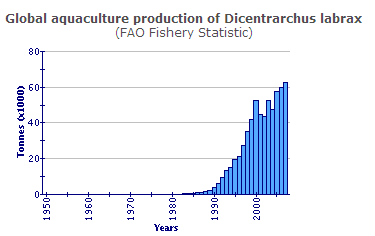
The evolution of the expansion in the production of farmed seabass took place particularly in Greece, Turkey, and Italy and there has been a slow down in expansion. Total production from all countries decreased from a peak of nearly 71 000 tonnes in 2000 to 57 000 in 2002. However, Spain and Croatia appear to be bucking this trend.
Market and trade
One of the largest success stories in European aquaculture has been the Mediterranean seabass industry, which in less than 15 years grew from a few thousand tonnes to 57 000 tonnes today, having peaked at nearly 71 000 tonnes in 2000. When farmed bass started getting to market in the late 1980s and early 1990s, the farmed quality was seen to complement the wild species and prices were very high. Prices of the wild product may have suffered initially, as the volumes from aquaculture continued growing, but today there is clear distinction in the market between wild and farmed product, with the prices for wild bass several times higher than those of the farmed fish.
Compared to many other species of farmed fish, such as salmon or trout, seabass has so far been mainly marketed whole and fresh, with only limited volumes undergoing any form of processing or value-addition. In any case, product development in the bass sector has been very limited. One major reason is the conservatism of Mediterranean consumers, who are used to seeing the fish whole when sold retail, despite the fact that the fish certainly would have been better if they had been gutted at source.
Some product development is now under way, both among the larger Greek producers and by specialised Italian fish processors who import Greek product and then repack it in modified atmosphere packaging (MAP), giving the product a longer shelf-life. However, more product development is certainly necessary if additional quantities of bass are to be absorbed in the current markets. Likewise, product penetration in Northern Europe is still very limited: it is based on ethnic restaurants (Greek, Turkish, and Spanish) but spurred by the growing popularity of the Mediterranean cuisine and diet.
Status and trends
In Europe, the seabass industry has grown strongly in the last decade. Production is mostly exported, mainly to Italy and Spain. The main exporter was Greece, with about 70 percent of domestic production exported. Italy was originally almost the only export market for Greek production but, as a result of market development efforts, its exports have now expanded into new markets, such as the United Kingdom, Germany and France, as well as Spain for certain sizes. At the opposite end of the scale, the trade in fingerlings comes from Italy, Spain and France and goes to farms in Greece, Malta and Croatia. As the output of seabass has grown costs were driven down, and market prices declined by more than two-thirds between 1990 and 2002 (from USD 16/kg to about USD 4-5/kg.
The rapid saturation of the market and the parallel rapid price decline (60-70 percent in ten years) are attributed to the much smaller traditional market for these species (mainly in southern Europe) compared with the Atlantic salmon market, the lack of diversified products, and limited market development and promotion. The substantial drop in prices of these species is, however, opening new markets and expanding existing ones, although acceptable profit margins at the production can only be sustained through further improvements in productivity and product diversification. Over-production in some countries has been a contributing factor in the decline in prices (supply exceeding demand), which has in turn probably been responsible for the general fall in total production of this species between 2000 and 2002.
Main issues
As in other animal production sectors, antibiotics are used in aquaculture, during both production and processing, mainly to prevent (prophylactic use) and treat (therapeutic use) bacterial diseases. Antibiotics have not always been used in a responsible manner in aquaculture and, in a number of reported situations, control of the use of antibiotics has not provided an adequate assurance of the prevention of risk to humans.
The consumption of antibiotics is leading to the development of antibiotic resistance in bacteria that are pathogenic to humans. The development of antibiotic resistance by pathogenic bacteria is considered to be one of the most serious risks to human health at the global level.
Recognition of the risks associated with the direct and indirect effects on human health of both active and passive consumption of antibiotics has led to bans on the use of certain antibiotics in animal food production (particularly those antibiotics for which no safe residue levels can be determined) and to the establishment of maximum residue limits (MRLs) for those with known risks.
Many governments around the world have introduced, changed or tightened national regulations on the use of antibiotics, in general and within the aquaculture sector.
Responsible aquaculture practices
Consumer pressure has resulted in the Agri-Food industry being forced to provide 'welfare friendly' products. There is practical merit in simply replacing the word 'welfare' by the term 'health and well-being'. Health is more than the mere absence of disease and well-being is more than just the absence of discomfort and emotional distress.
Legislation is being enacted in the EU countries in this region, which should follow the recommendations of the Standing Committee of the Council of Europe Convention on the Welfare of Animals Kept for Farming Purposes. The latter states that animals should have freedom from hunger and thirst, discomfort, pain, injury or disease, fear and distress and have freedom to express normal behaviour.
Present husbandry practices often question the capacity of animals to cope successfully with their living conditions. 'Coping' includes the normal regulation of body state and emergency responses, which require more energy expenditure and hence are used only when the animal predicts that normal regulatory actions will be inadequate. This sort of physical and psychological burden may give rise to poor welfare, meaning the state of an individual as regards its attempts to cope with the environment.
Integrated efforts can help to answer public questions regarding intensive production systems. Actually, veterinarians have the responsibility of the health assessment of reared animals; they control and measure the state of health with the aim of preventing disease. Thus they are the most suitable people to interact with the farm operatives and the government inspectors in examining the animals and deciding whether or not they are showing signs of good health and well-being. Nowadays veterinarians have the role of developing a new approach of enlarged diagnosis that places each problem in a specific context; this can be considered complementary to the traditional clinical diagnosis. It is possible in practice to place the patient (the animal) as a whole, and not the problem, in the centre of a specific interacting environment. Animal health in this sense would aim to create equilibrium between the animal and its new environment in intensive conditions.
February 2010



